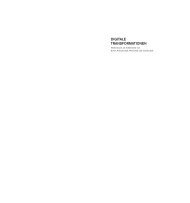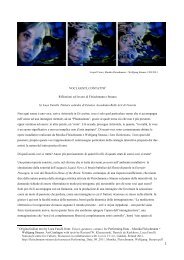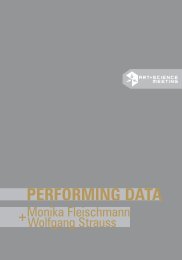Głosy, gesty, kontakt || Voices, gestures, contact
Voices, Gestures, Contact by Luca Farulli. Reflections about the work of Monika Fleischmann + Wolfgang Strauss. Luca Farulli writes about „Liquid Views“. „Liquid Views“ (1992/2013) is a simulation of artificial water in which the viewer’s reflection is portrayed as in real water. The computer as a storage media per se, artistically turned, tempts the visitor to leave its trace in the open system. Liquid Views predicts, cultural, social, technical and aesthetic changes that become evident 20 years later. In: Fleischmann, Monika; Strauss, Wolfgang: Performing Data | Performowanie danych with texts by Ryszard W. Kluszczyński, Derrick de Kerkhove (txt), Luca Farulli. National Centre for Culture, Warszawa 2011 with Laznia CCArt, Gdańsk, Poland 2011 ISBN 978-83-61587-55-2 http://fleischmann-strauss.de/resources/Luca-Farulli-VoicesGesturesContact-in-Performing_Data_2011.pdf
Voices, Gestures, Contact by Luca Farulli. Reflections about the work of Monika Fleischmann + Wolfgang Strauss.
Luca Farulli writes about „Liquid Views“. „Liquid Views“ (1992/2013) is a simulation of artificial water in which the viewer’s reflection is portrayed as in real water.
The computer as a storage media per se, artistically turned, tempts the visitor to leave its trace in the open system.
Liquid Views predicts, cultural, social, technical and aesthetic changes that become evident 20 years later.
In: Fleischmann, Monika; Strauss, Wolfgang: Performing Data | Performowanie danych with texts by Ryszard W. Kluszczyński, Derrick de Kerkhove (txt), Luca Farulli. National Centre for Culture, Warszawa 2011 with Laznia CCArt, Gdańsk, Poland 2011 ISBN 978-83-61587-55-2 http://fleischmann-strauss.de/resources/Luca-Farulli-VoicesGesturesContact-in-Performing_Data_2011.pdf
Create successful ePaper yourself
Turn your PDF publications into a flip-book with our unique Google optimized e-Paper software.
głosy owych dźwięków? Tylko dla tego,<br />
kto towarzyszy im z wyobrażeniem,<br />
z tworzeniem obrazu przywracającego<br />
uczucie niczym odruch pasji, obrazem,<br />
w którym odbiorca rozpoznaje siebie<br />
samego w stanie odmienionym. W grę<br />
nie wchodzi tu właściwość statyczna<br />
– pamięć, lecz dynamiczna – wyobraźnia:<br />
„przekaz elektroniczny i masowe<br />
migracje naznaczają dzisiejszy świat –<br />
pisze Arjun Appadurai – nie jako nowe<br />
siły techniczne, ale jako siły, które pobudzają<br />
(a niekiedy wymuszają) pracę<br />
wyobraźni”, która „nie ma charakteru<br />
ani czysto emancypacyjnego, ani całkowicie<br />
podporządkowanego”, lecz jest<br />
„przestrzenią kontestacji, w której jednostki<br />
i grupy starają się dołączyć to,<br />
co globalne, do własnych sposobów<br />
nowoczesnego bycia” 2 . Wyobraźnia rozumiana<br />
jako siła odpowiadająca za projekcję<br />
siebie, jako pole narodzin obrazu<br />
będącego „dialektyką”, ponieważ zarysowuje<br />
się błyskawicznie w momencie<br />
„maksymalnego napięcia pomiędzy przeciwieństwami<br />
dialektycznymi” w myśl<br />
deinicji Waltera Benjamina, zawieszona<br />
niczym „fantazmat” „między widzialnym<br />
i niewidzialnym, między manifestowanym<br />
i ukrywanym, między materialnym<br />
i niematerialnym, dotykalnym i niedotykalnym,<br />
między głosem i fenomenem” 3 .<br />
Instalacja Liquid Views stanowi – w tej<br />
optyce – wzorzec wyjaśniający stan<br />
2 Arjun Appadurai, Nowoczesność<br />
bez granic. Kulturowe wymiary globalizacji, tłum.<br />
Z. Pucek, Wyd. TAiWPN Universitas, Kraków 2005,<br />
ss. 11-12.<br />
3 Nicholas Mirzoef, Ghostwriting: working<br />
out visual culture, w: „Journal of visual culture”,<br />
Aug. 2002, Vol.1 (2), s. 239. (Tekst jest także<br />
dostępny w formie elektronicznej pod adresem:<br />
www.nicholasmirzoef.com/Images/Mirzoef_<br />
ghoswriting.pdf.)<br />
impulsively restoring a feeling; an image<br />
which reflects the beholder himself<br />
in an altered state. It is not about the<br />
static property – memory, but the dynamic<br />
one – imagination. According to<br />
Arjun Appadurai, “electronic mediation<br />
and mass migration mark the world<br />
of the present not as technically new<br />
forces but as ones that seem to impel<br />
(and sometimes to compel) the work of<br />
imagination,” which “is neither purely<br />
emancipatory or entirely disciplined,”<br />
but is a “space of contestation in which<br />
individuals and groups seek to annex<br />
the global into their own practices of<br />
the modern.” 2 Imagination is hereby<br />
understood as a force responsible for<br />
self-projection, as a field of birth of an<br />
image being “dialectics,” because it becomes<br />
instantaneously outlined in the<br />
moment of “maximum tension between<br />
dialectical oppositions,” along Walter<br />
Benjamin’s definition, suspended like<br />
a “phantasm” “between the visible and<br />
the invisible, the material and the immaterial,<br />
the palpable and the impalpable,<br />
the voice and the phenomenon.” 3<br />
In this regard, Liquid Views provides<br />
a model explaining the ontological status<br />
of the viewer inside artistic environments<br />
of Fleischmann and Strauss.<br />
The specific nature of their interactive<br />
strategy goes beyond the mere realization<br />
of the work, beyond simple reactions<br />
to the realm presented by the<br />
2 Arjun Appadurai: Modernity at large:<br />
cultural dimensions of globalization. University<br />
of Minnessota Press, 2003. 4.<br />
3 Nicholas Mirzoef: “Ghostwriting: working<br />
out visual culture,” in: Journal of visual culture,<br />
Vol. 1 (2), Aug. 2002, p. 239. Full text available<br />
at: www.nicholasmirzoef.com/Images/Mirzoef_<br />
ghoswriting.pdf.







